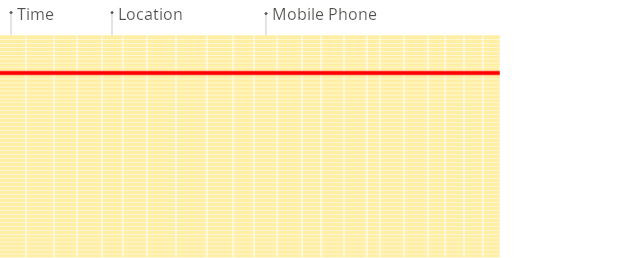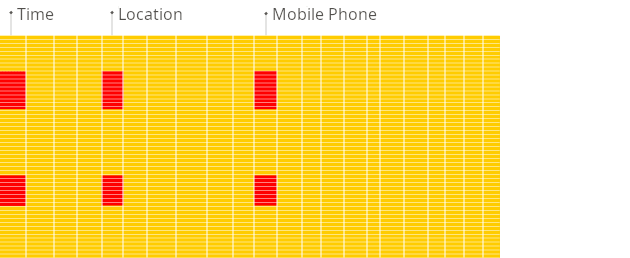Problem
Map lookup such as a['key'] works with linear complexity (mentioned here) and can be inefficient. This is because selecting a value with a specific key from a table would require iterating through all keys (~M) across all rows (N) in the Map column, resulting in ~MxN lookups.
A lookup using Map can be 10x slower than a String column. The experiment below also shows ~10x slowdown for cold query, and difference in multiple magnitudes of data processed (7.21 MB vs 5.65 GB).
-- create table with SpanNAme as String and ResourceAttributes as Map
DROP TABLE IF EXISTS tbl;
CREATE TABLE tbl (
`Timestamp` DateTime64(9) CODEC (Delta(8), ZSTD(1)),
`TraceId` String CODEC (ZSTD(1)),
`ServiceName` LowCardinality(String) CODEC (ZSTD(1)),
`Duration` UInt8 CODEC (ZSTD(1)), -- Int64
`SpanName` LowCardinality(String) CODEC (ZSTD(1)),
`ResourceAttributes` Map(LowCardinality(String), String) CODEC (ZSTD(1))
)
ENGINE = MergeTree
PARTITION BY toDate(Timestamp)
ORDER BY (ServiceName, SpanName, toUnixTimestamp(Timestamp), TraceId);
-- create UDF to generate random Map data for ResourceAttributes
DROP FUNCTION IF EXISTS genmap;
CREATE FUNCTION genmap AS (n) -> arrayMap (x-> (x::String, (x*rand32())::String), range(1, n));
-- check that genmap is working as intended
SELECT genmap(10)::Map(String, String);
-- insert 1M rows
INSERT INTO tbl
SELECT
now() - randUniform(1, 1000000.) as Timestamp,
randomPrintableASCII(2) as TraceId,
randomPrintableASCII(2) as ServiceName,
rand32() as Duration,
randomPrintableASCII(2) as SpanName,
genmap(rand64()%500)::Map(String, String) as ResourceAttributes
FROM numbers(1_000_000);
-- querying for SpanName is faster
-- [cold] 0 rows in set. Elapsed: 0.642 sec. Processed 1.00 million rows, 7.21 MB (1.56 million rows/s., 11.22 MB/s.)
-- [warm] 0 rows in set. Elapsed: 0.164 sec. Processed 1.00 million rows, 7.21 MB (6.10 million rows/s., 43.99 MB/s.)
SELECT
COUNT(*),
avg(Duration/1E6) as average,
quantile(0.95)(Duration/1E6) as p95,
quantile(0.99)(Duration/1E6) as p99,
SpanName
FROM tbl
GROUP BY SpanName ORDER BY 1 DESC LIMIT 50 FORMAT Null;
-- query for ResourceAttributes is slower
-- [cold] 0 rows in set. Elapsed: 6.432 sec. Processed 1.00 million rows, 5.65 GB (155.46 thousand rows/s., 879.07 MB/s.)
-- [warm] 0 rows in set. Elapsed: 5.935 sec. Processed 1.00 million rows, 5.65 GB (168.50 thousand rows/s., 952.81 MB/s.)
SELECT
COUNT(*),
avg(Duration/1E6) as average,
quantile(0.95)(Duration/1E6) as p95,
quantile(0.99)(Duration/1E6) as p99,
ResourceAttributes['1'] as hostname
FROM tbl
GROUP BY hostname ORDER BY 1 DESC LIMIT 50 FORMAT Null;
Solution To improve the query, we can add another column with the value defaulting to a particular key in the Map column, and then materializing it to populate value for existing rows. This way, we extract and store the necessary value at insertion time, thereby speeding up the lookup at query time.
-- solution is to add a column with value defaulting to a particular key in Map
ALTER TABLE tbl ADD COLUMN hostname LowCardinality(String) DEFAULT ResourceAttributes['1'];
ALTER TABLE tbl MATERIALIZE COLUMN hostname;
-- query for hostname (new column) is now faster
-- [cold] 0 rows in set. Elapsed: 2.215 sec. Processed 1.00 million rows, 21.67 MB (451.52 thousand rows/s., 9.78 MB/s.)
-- [warm] 0 rows in set. Elapsed: 0.541 sec. Processed 1.00 million rows, 21.67 MB (1.85 million rows/s., 40.04 MB/s.)
SELECT
COUNT(*),
avg(Duration/1E6) as average,
quantile(0.95)(Duration/1E6) as p95,
quantile(0.99)(Duration/1E6) as p99,
hostname
FROM tbl
GROUP BY hostname ORDER BY 1 DESC LIMIT 50 FORMAT Null;
-- drop cache to run query cold
SYSTEM DROP FILESYSTEM CACHE;

